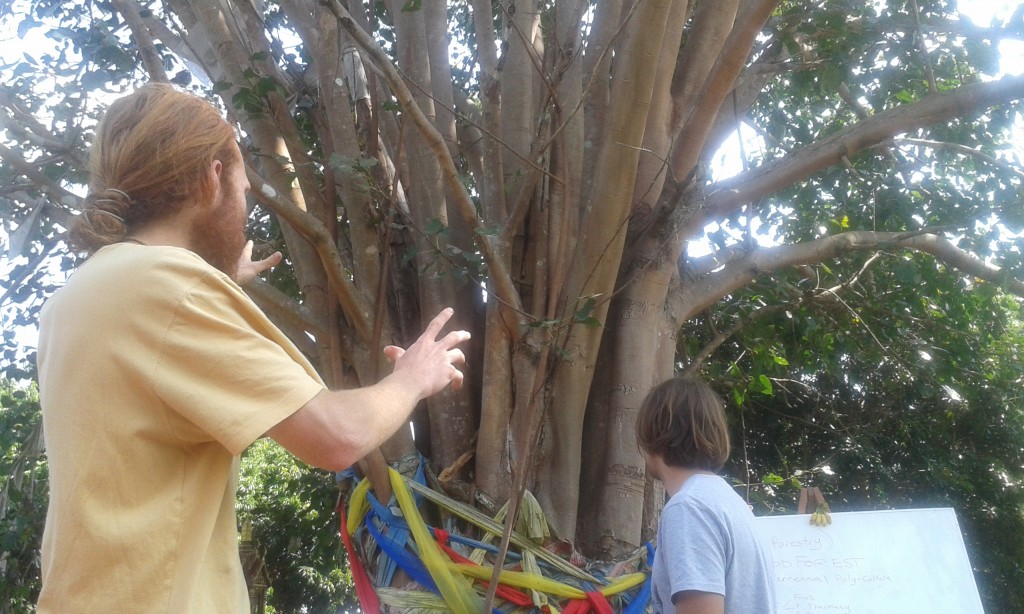
Principle: Plant useful trees
Trees are a central point of a forest ecosystem. They are productive, stable, self-maintaining, self-regulating, clean air-producing, water-storing, temperature-moderating, fertility-increasing organisms. Trees also:
- Provide habitats for other creatures, from microorganisms to monkeys,
- Insulate snow from melting and thus secures a water source for a longer period of time,
- Create transpiration. An ordinary elm tree will evapo-transpirate up to 15,000 liters of water on a clear hot day.
- Absorb rainwater. When it rains, water falls through the canopy, into the trunk and into the humus. After contact with each of these organisms, water accumulates microorganisms and soaks into the soil.
Trees embody the philosophy of permaculture. As Bill Mollison says, “without trees, humans could not inhabit the earth.”
Planting trees
There are many methods for planting trees. Here is one:
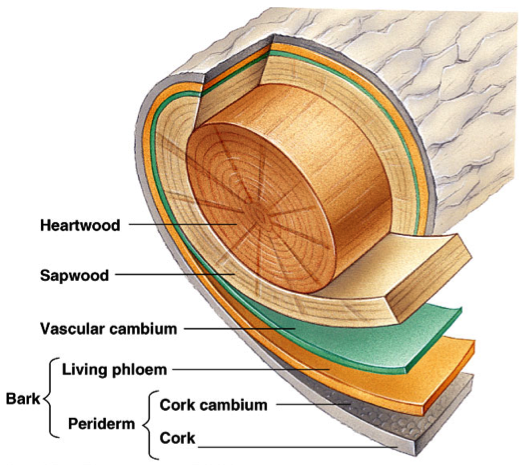
- Dig a hole twice as deep as the root base
- The hole should be in the shape of a wok, slightly rounded at the bottom to collect water. At the bottom of the hole, you can add coconut husks, banana leaf plates or other dense organic material.
- Set tree. Add 3-4 handfuls of compost depending on the size. Mix compost with the removed soil, adding less and less compost the closer to the top. This introduces the existing soil with the compost and will help the tree to establish a root system.
- Cover the whole area with mulch, avoid putting mulch directly next to the trunk.
- If on a slope, add a berm to the top-side of the hole to catch rainwater. Water will seep into the ground above the tree and provide water to the roots. Or, as mentioned in the earthworks chapter, you can dig a fish scale swale at the bottom. Water will soak into the soil and encourage roots to grow deep.
Here’s an image which has some good tips on planting trees
No-till tree planting
This procedure allows tree roots to penetrate the hardpan and not disturb the existing soil ecosystem (practiced at Sadhana Forest, India):
- Select tree sites and water the ground for 2-3 days before planting to loosen the hardpan.
- Once soaked, place a large PVC pipe 12” wide PVC pipe where the tree will be planted. Build a mound of soil around the PVC and make a berm on the upper side of the slope using the existing soil.
- Inside the PVC, fill a layer with humanure and compost 50:50. Then place the tree and fill the rest of the PVC with mixed compost and existing soil.
Wick irrigation technique
One method to water trees throughout the day, also practiced at Sadhana Forest, is to make a cotton wick out of a 2L plastic bottle to water trees slowly all day:
- Cut a small hole the size of the wick in the bottom of the bottle.
- Push in a cotton wick and leave about 20 centimeters outside the bottle. Seal with wax or silicone.
- Fill the bottle with water and crack the top to let only the tiniest amount of air into the bottle. This technique could stretch 1L to last a week, a good amount of water required for a tree-taking root.
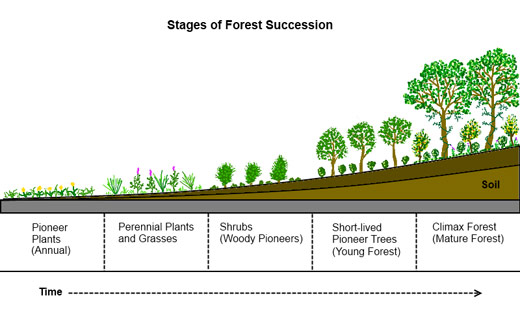
Forests
A forest is a large area of land covered with trees or other woody vegetation. Forests are the dominant terrestrial ecosystem on Earth. Forests contain 80% of the Earth’s plant biomass. Forests have many yields. Some of these yields include food, fuel, fiber, fertilizer, fodder, pharmaceuticals (farma) and fun.
Succession
Succession is process by which an area undergoes more or less orderly and predictable changes following disturbances or initial colonization of a new habitat. To understand forest growth and thus how to design a forest, we need to understand succession.
Primary Succession
This stage begins with barren rock or mineral substrate. Weather breaks down the minerals of the rock. Then bacteria, lichens, algae and mosses grow on the bare rock. This layer can last hundreds, thousands or even millions of years.
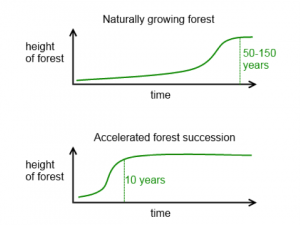
Secondary Succession
Once vegetation arises from the substrate, an area enters secondary succession. Succession generally advances in a similar pattern:
- Annual herbs and perennial plants – Grasses and herbaceous plants
- Shrubs – Woody weeds which are thorny to protect soil
- Understory trees – Creates shade for the new ecosystem
- Climax trees– Mature forest
Accelerating succession
Forests take decades, even centuries, to mature on their own. But humans accelerate this process to establish a forest in less than a decade.
Layers of a forest
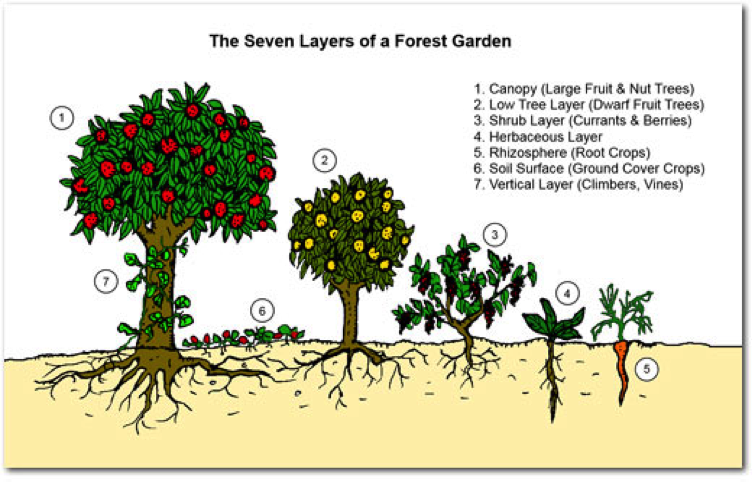
In a mature forest, there are many types of vegetation thriving and growing and living and dying and becoming forest mulch. By observing the different layers of a forest, we can more effectively and more rapidly grow forests. The seven common layers of a forest are listed below. There are variations of this list. Some people consider root crops as a layer. Others consider the forest floor as a layer. It doesn’t really matter how you define it – it’s important to understand there are different layers. And we can plant these layers to recreate succession and accelerate the growth of a forest.
Canopy (including emergent layer) – Typically 8-12 meters tall, canopy trees range from timber trees, nut and fruit trees.
Understory layer– Typically 3-9 meters tall. This layer consists mainly of shorter trees. Some are young trees, but others are trees that grow slowly because they didn’t get enough light filtering through the canopy. The majority of fruit trees fall into this layer.
Shrub layer – Typically around 3 meters tall, the shrub layer includes mature shrubs and bushes, fruiting bushes, flowering, medicinal and other beneficial plants as well.
Herbaceous layer – The herb layer is typically small, perennial plants. Many perennial, culinary, medicinal and other beneficial plants and herbs are in this layer.
Groundcover layer – Groundcover layer crops are often shade tolerant, grow much closer to the ground, grow densely to fill bare patches of soil and often can tolerate some foot traffic. The groundcover layer includes soil surface crops and nitrogen fixers.
Vine or climbing layer – Vines span multiple heights depending on how they grow. They are a great way to add more productivity to a small space. It is important to keep them trimmed so they are easy to harvest.
Mycelia or Fungal layer – Fungal networks in forest soils are nutrient and communication highways. Their health is inseparable to that of a forest garden. Unlike other soil life, we can sow, manage and harvest products from fungus.
Support species
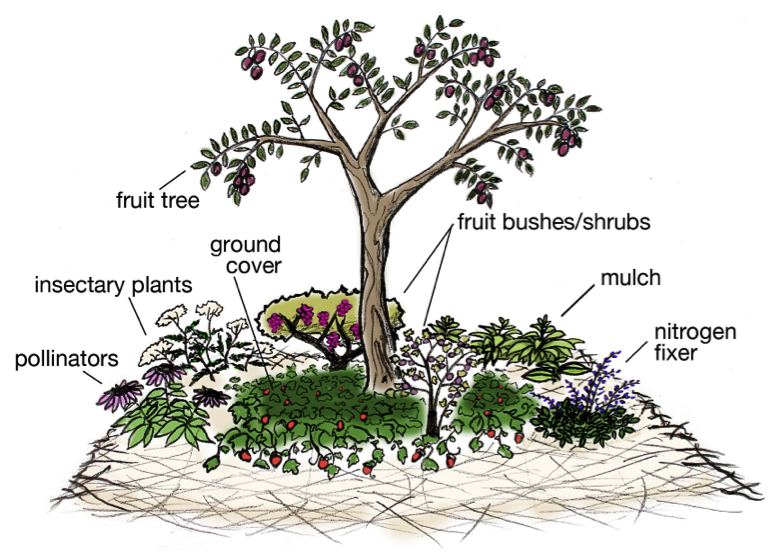
Support species plants are good to plant near trees to provide nitrogen, keep pests away, attract insect among other benefits. Local areas will usually have several varieties of naturally growing legumes, groundcovers and insect attractors. Finding and planting those plants is a good strategy.
Legumes
Legumes can grow with little to no other vegetation. They colonize degraded land and “fix” nitrogen in the soil so it is more accessible for other plants. Legumes include nitrogen-fixing plants, dynamic accumulators and general pioneer species. Some say, legumes are the lungs of the soil, enabling other plants to breathe.
Ground cover
Groundcover plants protect soil from erosion and keep unwanted plants away. Groundcover plants include grasses, bulbs and some nitrogen-fixing legume plants.
Insect attractors
Typical insects attracted by these types of plants include lacewings, ladybugs, hover flies, tachinid flies and mini-wasps among other beneficial insects. These types of plants include flowers, aromatic herbs, salt tolerant flowers and other herbs and spices.
This will attract beneficial insects and repel unwanted aphids and insects from your plants.
7 support species: 1 tree species
A healthy tree guild will have 7 supporting plants for every canopy tree. Consider 7:1 as a rough estimate. Oftentimes you will be limited by the availability of plants, space or other resources.
Food Forests
A food forest is a perennial polyculture of multi-purpose plants. It is a multi-year, multi-plant, multi-function forest. A food forest is a forest where most if not all of the species are edible or useful in some manner. Designing a food forest requires an analysis of different tree patterns and tree and plant species.
As a general rule, in the tropics you start with 90% legume trees, 10% fruit trees and 20 years later you have 10% legumes, 90% fruit. Note: You can plant up to 400 plants in a 6m x 6m area. As the plants grow, you can thin them out. It is easier to cut out than to plant later.
Planting a food forest
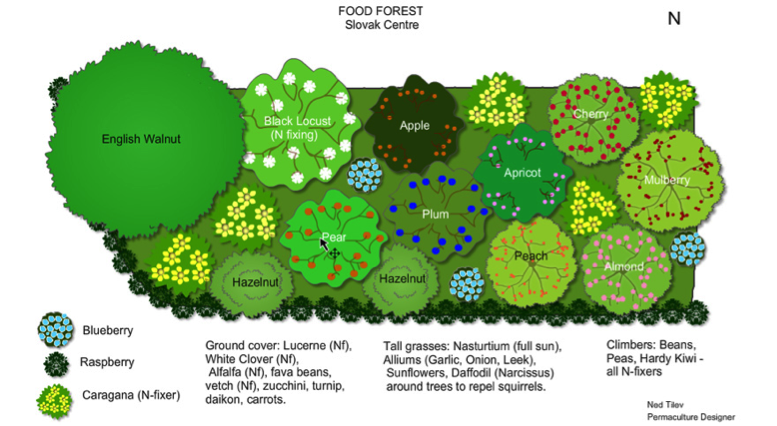
Here are a few guidelines for planting a food forest:
- Earthworks – Do any necessary earthworks to prepare the land for water retention (See Earthworks)
- Mulch – Of the existing organic material, deicide what to keep and what to compost. Make compost with existing brush. Mulch heavily.
- Tree selection – When selecting a species, go to local nurseries to see what trees are available and grow well. Look around on your site. What trees can you air layer or take cuttings from to plant in your nursery? Go to your local organic market. Buy a bunch of fruit. Let it rot. Collect the seeds. Observe what grows. Consider what supporting plants and trees will grow in your area and be good companions to your canopy trees.
- Design – It is helpful to make a sketch of the area you have to create a forest. Include paths, compost areas, benches and general patterns of tree designs you want to plant. Consider these shapes when designing your forest:
- Alley-cropping
- Island guilds
- Radial
- Scatter
- Intercropping
- Observe – After the initial planting, observe your forest frequently (at least once a week after planting). Consider the following on these observatory walks:
- Are the plants receiving enough nutrients and water? Is there damage or discoloration to the leaves? Are they being eaten? Which trees/plants are doing better than others? Why? Are they producing or starting to fruit?
- Add mulch or compost – Adding 5-10cm of compost/mulch is like a fresh meal for the soil. Also add compost and mulch to trees 1 month before the rain starts and 1 month before the rain ends.
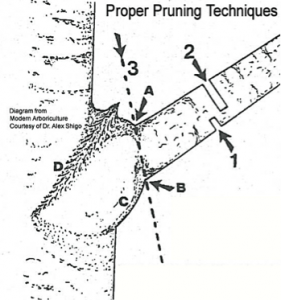
Coppicing
Coppicing is when you cut a tree back to its stump with the intention that it will sprout again. Coppicing is generally done to fix nitrogen in the soil, let more light into an area, encourage the plant to grow more thickly as in a living fence, or provide wood for mulch, firewood, fodder or building.
These methods are more efficient than replanting because the plant’s root structure remains alive and in the soil. Coppicing can be done yearly or every ten years, depending on the climate and species. Pollarding is a similar technique where you remove the upper branches of a tree to promote a dense head of foliage and branches.
Pruning
Pruning is when you cut away dead or overgrown branches to encourage fruitfulness and growth. Here is an illustration of how to properly prune a tree and how to select what branches to cut. It’s best to prune at the beginning of the rainy season to give trees the most time to recover.
Chop and Drop
Chop and drop is the process of “chopping” branches and “dropping” them on the forest floor. Leaves and branches slowly decompose over time and add nitrogen to the soil.